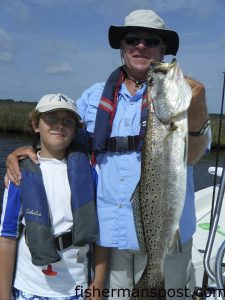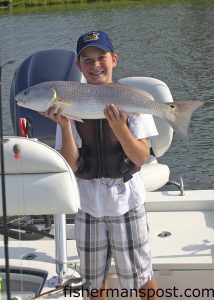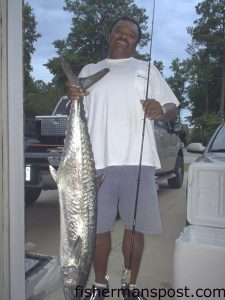Swansboro August 12, 2010

Tom Temple, of Pine Knolll Shores, and his grandson with a gator speckled trout they hooked in the White Oak River while fishing with Capt. Jeff Cronk of Fish'N4Life Charters.
Jeff, of Fish’N4Life Charters, reports that the inshore red drum bite has been solid lately, though most of the fish are scattered throughout the shallow bays. Rising tides have been producing the best action, and live shrimp and mullet under popping corks, topwater plugs, and soft baits like the new Gulp Ripple Mullet are attracting their attention.
The shallow flats and bays are also holding plenty of flounder (most 14-16”), and targeting smaller creek mouths on falling tides has been particularly effective lately. Spinnerbaits with 3-4” paddle tail grubs are one of the most effective flounder foolers in the shallows, and anglers are hooking up on live finger mullet and mud minnows on Carolina rigs in the deeper water along ICW docks.
Bluefish and spanish mackerel are busting baits on the inlet shoals, especially on rising tides. Free-lining small live baits and casting metal jigs and spec rigs to the feeding schools will fool both fish.
Larger spanish (to 5+ lbs.) and king mackerel are feeding on nearshore structure and along the beachfront between the inlet and the pier. Live-baiting is the way to go for both fish. Smaller pogies (4-5”) are best for the spanish, while larger baits (6-8”) will tempt bites from the kings. Lighter and shorter leaders (12” or less) and smaller #6 trebles suit the spanish, versus the heavier 1-2’ leaders and larger #4 trebles anglers should be using for the kings.
The nearshore flounder bite is still excellent, with anglers averaging double-digit numbers and about 1/3 keepers. Bouncing a bucktail tipped with a Gulp shrimp or pogie off the bottom will outfish live-baiting for the nearshore flatties every time.

Logan Hislop with his first topwater red drum. He hooked the 29" fish behind Bear Island while fishing with Capt. Rick Patterson of Cape Crusader Charters. Photo courtesy of Lew McCloud.
Chesson, of CXC Fishing Charters, reports that the nearshore spanish and king mackerel bite remains excellent for anglers slow-trolling or drifting live baits around nearshore structure and the inlet tidelines.
Further offshore, bottom fishing has been very productive for triggerfish, sea bass, and gag groupers. There’s been plenty of life on spots in the 60-70’ range lately, so anglers don’t have to go too far to get in on the action. Squid will fool the smaller bottom feeders, while live baits and bucktails tipped with cigar minnows or other baits will attract attention from the grouper.
Jordan, of The Reel Outdoors, reports that not many people are targeting them, but large king mackerel (20-40 lbs.) and big spanish (to 5+ lbs.) are feeding within a few miles of the beaches. Live-baiting is the way to go for both mackerels, with smaller baits for the spanish and larger ones for the kings.
Smaller spanish are falling for trolled Clarkspoons and other lures along the beachfront and just offshore.
Flounder are feeding on nearshore structure, and they will fall for bouncing Gulp-tipped bucktails off the bottom.
Anglers making the run to the Gulf Stream are finding an occasional wahoo and a decent billfish bite. Some sailfish have been reported as close in as 25 miles out. Rigged ballyhoo are the go-to baits for the wahoo and bills.
Inshore, the red drum bite is decent in the marshes, but it’s not incredible. Anglers should be able to fool a few with live baits, topwater plugs, and Gulps.
Spot are showing up in the waterway and for surf and pier bottom fishermen. Bloodworms and shrimp will get their attention.

Eddie Perry, of Raleigh, with a 45 lb. king mackerel he hooked off the beach at Emerald Isle while casting a live finger mullet into a school of pogies for spanish mackerel.
Billy, of Bogue Inlet Pier, reports that anglers have been picking up some spot, whiting, and croaker while bottom fishing at night.
Small live baits are fooling a few flounder.
Bluefish and a few spanish mackerel are falling for Gotcha plugs and other lures that anglers are working quickly from the planks.
